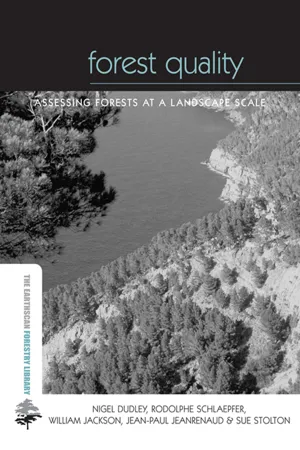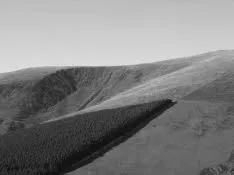![]()
Part 1
Measuring Forest Quality
![]()
1 | What is Forest Quality? |
The Tree that moves some to tears of joy is in the Eyes of others only a Green thing that stands in the way
The poet and artist William Blake, circa 1800 in a letter to Reverend John Trusler
In the foothills of the Snowdonia National Park, in Wales, we’re looking for an abandoned village; a scatter of houses left behind when a slate quarry closed. It is marked on the map and clearly visible from the road, but is nowadays surrounded by a dense sward of conifers in one of the state-owned forests. We are probably trespassing, forcing our way up a steep slope – often literally on our hands and knees – through dense stands of Sitka spruce. No-one can have been in here for years. The ground is covered with a thick mat of needles, empty of any plants except for the odd place where a windfall has created a little pool of light and life; and here the burst of green forms a sudden contrast with the featureless surroundings. The dense foliage muffles sounds as well, so that we are in virtual silence. It’s peaceful, but rather unreal.
The few ruins, when we finally reach them, seem as remote as a village hidden away in a tropical jungle and it is hard to imagine this place as it must have been 50 years ago, stuck out on the edge of a bare hillside, with quarrymen patiently cutting slates for roofing. Most of the men died young, their lungs clogged with decades’ worth of thick dust. This operation was obviously abandoned in a hurry. There are still hundreds of slates stacked neatly as if ready for sale, although they are now frost-shattered and covered in a thick growth of lichen, and all the cottages have lost their roofs.
We take a different route out, slithering uncomfortably down a slope where tree branches pull at our faces and hair, but then suddenly burst out into a scrap of remnant oak woodland left around the banks of a stream. The change is immediate, like switching on a light in a darkened room, a burst of new colours and sounds. There is a range of trees: sessile oaks interspersed with birch, hazel and yew. Twisted tree branches are dripping with lichens and mosses, and we have to clamber over fallen logs, while underfoot there is a rich profusion of flowers and ferns. The trees are full of birdsong and overhead the mewing call of a buzzard sounds above the canopy.
Note: In the Snowdonia National Park, Wales, ancient native woodlands and exotic conifer plantations are both labelled ‘forests’ but their qualities are very different.
Source: Nigel Dudley
FIGURE 1.1 Two views of Snowdonia
The two worlds, pressed up against each other physically, remain in other ways a universe apart. Yet both the conifer plantation and the oak wood are ‘forests’. And they both have their uses and their champions. At the heart of this book lies an attempt to understand the differences between the quality of different forests – many far more subtle than the deliberately stark example from Wales – and what ‘forest quality’ means in practice.
Quantity and Quality
Everybody knows that the world is losing forests – images of deforestation fill our magazines and television screens. But it is not just the number of trees that matters; the quality of the forest is also important. Even where the forest area is stable or increasing, there are often rapid changes in its character. Natural forests are being replaced by plantations or by intensively managed forests. Forests around the world are generally becoming younger and less diverse, in both species and structure; this has important impacts for biodiversity and also affects many human values.
A tree plantation is as different from a natural forest as a football pitch is from a wildflower meadow: both may have their place in the forested landscape but it is important that we distinguish between them and understand their different qualities.
Throughout the 1980s and early 1990s, global concerns about forest conservation focused on the rapid rate of deforestation in tropical countries. While this is a real and continuing issue, it is only one half of a more complex problem of global forest management. Growing interest in the status of temperate and boreal forests resulted in recognition of the importance of social or ecological values. Forest quality was recognized to be as important an issue as the quantity of forest remaining (Dudley, 1992).
There is a growing perception that global forest quality is declining as a result of human activities. Ecologists have become concerned about the replacement of biologically rich old-growth forest with species-poor young forests, intensively managed forests or plantations and the decline in the health of trees and other forest species as a result of anthropogenic changes, especially air pollution and climate change, but also as a result of introduced pests and diseases and invasive species. This in turn has led to a breakdown in the ecological support systems associated with forests including hydrological systems, soil structure and fire ecology. People interested in social welfare and development complain about threats to social rights in forests including issues related to tenure, access and changes of management that have resulted in a decline in non-wood goods and services (NWGS). Lastly and more generally, the changes are resulting in more intangible and hard-to-measure losses to the aesthetic, cultural and spiritual values that many people demand from forests.
Each of these aspects of ‘forest quality’ has its own champions and detractors. The public debate about the role of both plantations (Carrere and Lohmann, 1996) and air pollution (Dudley et al, 1985), for instance, has frequently been bitter. In those countries where forest cover has stabilized – particularly in the richer temperate and boreal countries of Europe, the Commonwealth of Independent States, the US, Japan, Australia and New Zealand – the debate about forests has shifted from how much forest we need to what kind of forests remain or could be recreated.
Although the discussion about forest quality initially centred on temperate and boreal forests, as it gained attention, concern about quality has spread to tropical areas as well. The focus of conservationists working in the tropics has been on conserving remaining areas of primary forest. A sharp distinction has been made – at least in theory – between ‘natural forest’ and ‘disturbed forest’, although these categories are often poorly defined. Forest that has been disturbed or selectively logged is frequently relegated to a low status in terms of its conservation value. Indeed, it is sometimes not referred to as ‘forest’ at all; it is for example not uncommon to hear conservationists say that a country like Cameroon has ‘barely any forest left at all’, even though around 20 million hectares of the country is covered by predominantly natural forest vegetation (Global Forest Watch, 2000). However, this distinction is becoming increasingly hard to maintain as more and more areas of apparently remote tropical forests are also disturbed – sometimes dramatically. A research study published by the German technical development organization Deutsche Gesellschaft für Technische Zusammenarbeit (GTZ) estimated that 32 per cent of forests in the tropics are ‘secondary’ even using a fairly coarse definition of secondary as open forest, long fallow and fragmented forest (Emrich et al, 2000). A more precise definition, including all forests where disturbance has taken place in the recent past, would include a much larger proportion of the total.
But What Exactly is Forest Quality?
Quality means different things to different people. Commercial timber producers will probably not look at a forest in the same way as local villagers, holidaymakers or indigenous people. Yet their views are all valid. The needs of wild plants and animals may not always be the same as our own. Forests give us an astonishing range of goods and services, and reconciling these within a policy of sustainable forest management presents a major challenge to planners and managers. Some countries, such as Germany, have attempted to achieve this by managing forests so that each particular forest stand supplies a wide range of economic, social and environmental benefits, while countries like New Zealand have made a sharp distinction between commercial timber and fibre plantations and ‘natural’ forests managed for biodiversity and social values.
In practice, some qualities are hard to reconcile: for example timber production and wilderness values. Many forests that...


